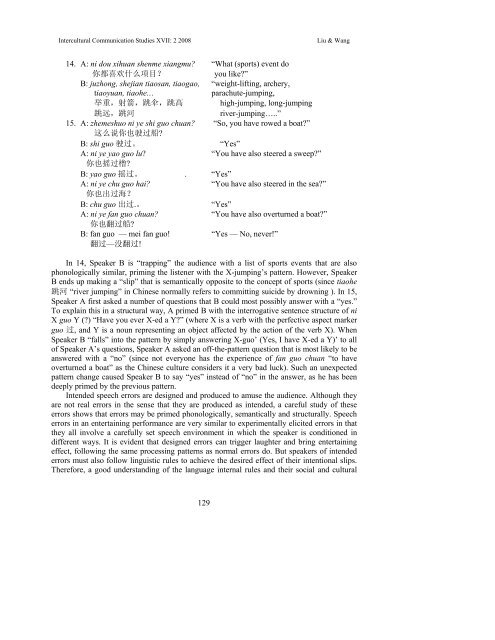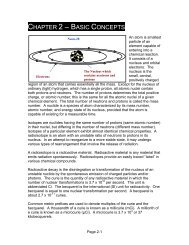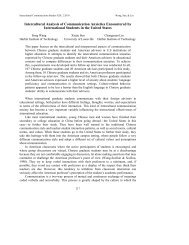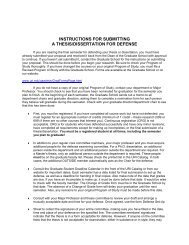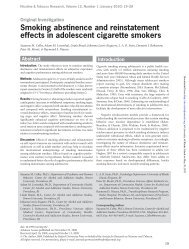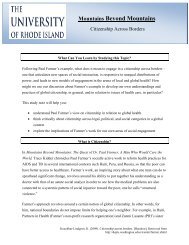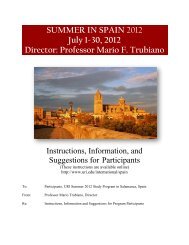Socio-cultural Impacts on Communication Slips
Socio-cultural Impacts on Communication Slips
Socio-cultural Impacts on Communication Slips
You also want an ePaper? Increase the reach of your titles
YUMPU automatically turns print PDFs into web optimized ePapers that Google loves.
Inter<str<strong>on</strong>g>cultural</str<strong>on</strong>g> Communicati<strong>on</strong> Studies XVII: 2 2008 Liu & Wang<br />
14. A: ni dou xihuan shenme xiangmu? “What (sports) event do<br />
你都喜欢什么项目? you like?”<br />
B: juzh<strong>on</strong>g, shejian tiaosan, tiaogao, “weight-lifting, archery,<br />
tiaoyuan, tiaohe… parachute-jumping,<br />
举重,射箭,跳伞,跳高 high-jumping, l<strong>on</strong>g-jumping<br />
跳远,跳河 river-jumping…..”<br />
15. A: zhemeshuo ni ye shi guo chuan? “So, you have rowed a boat?”<br />
这么说你也驶过船?<br />
B: shi guo 驶过。 “Yes”<br />
A: ni ye yao guo lu? “You have also steered a sweep?”<br />
你也摇过橹?<br />
B: yao guo 摇过。 . “Yes”<br />
A: ni ye chu guo hai? “You have also steered in the sea?”<br />
你也出过海?<br />
B: chu guo 出过.。 “Yes”<br />
A: ni ye fan guo chuan? “You have also overturned a boat?”<br />
你也翻过船?<br />
B: fan guo — mei fan guo! “Yes — No, never!”<br />
翻过—没翻过!<br />
In 14, Speaker B is “trapping” the audience with a list of sports events that are also<br />
ph<strong>on</strong>ologically similar, priming the listener with the X-jumping’s pattern. However, Speaker<br />
B ends up making a “slip” that is semantically opposite to the c<strong>on</strong>cept of sports (since tiaohe<br />
跳河 “river jumping” in Chinese normally refers to committing suicide by drowning ). In 15,<br />
Speaker A first asked a number of questi<strong>on</strong>s that B could most possibly answer with a “yes.”<br />
To explain this in a structural way, A primed B with the interrogative sentence structure of ni<br />
X guo Y (?) “Have you ever X-ed a Y?” (where X is a verb with the perfective aspect marker<br />
guo 过, and Y is a noun representing an object affected by the acti<strong>on</strong> of the verb X). When<br />
Speaker B “falls” into the pattern by simply answering X-guo’ (Yes, I have X-ed a Y)’ to all<br />
of Speaker A’s questi<strong>on</strong>s, Speaker A asked an off-the-pattern questi<strong>on</strong> that is most likely to be<br />
answered with a “no” (since not every<strong>on</strong>e has the experience of fan guo chuan “to have<br />
overturned a boat” as the Chinese culture c<strong>on</strong>siders it a very bad luck). Such an unexpected<br />
pattern change caused Speaker B to say “yes” instead of “no” in the answer, as he has been<br />
deeply primed by the previous pattern.<br />
Intended speech errors are designed and produced to amuse the audience. Although they<br />
are not real errors in the sense that they are produced as intended, a careful study of these<br />
errors shows that errors may be primed ph<strong>on</strong>ologically, semantically and structurally. Speech<br />
errors in an entertaining performance are very similar to experimentally elicited errors in that<br />
they all involve a carefully set speech envir<strong>on</strong>ment in which the speaker is c<strong>on</strong>diti<strong>on</strong>ed in<br />
different ways. It is evident that designed errors can trigger laughter and bring entertaining<br />
effect, following the same processing patterns as normal errors do. But speakers of intended<br />
errors must also follow linguistic rules to achieve the desired effect of their intenti<strong>on</strong>al slips.<br />
Therefore, a good understanding of the language internal rules and their social and <str<strong>on</strong>g>cultural</str<strong>on</strong>g><br />
129


